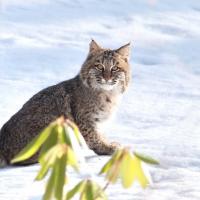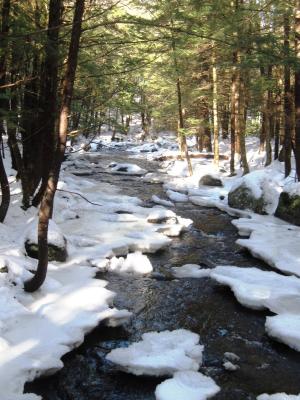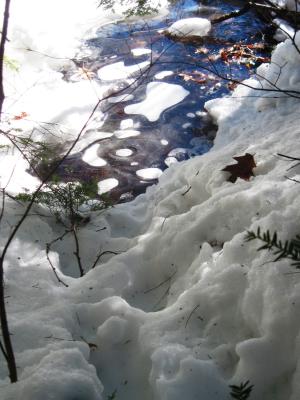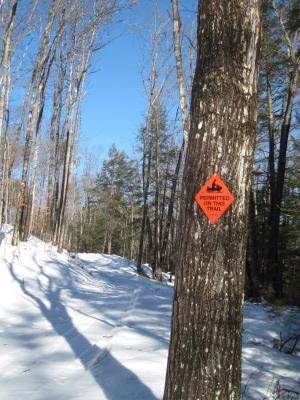- Tags:
- Wildlife

On the way to Salmon Brook in Sanbornton, N.H., on a misty winter morning. Brenda Charpentier photo.
A half hour after sunrise, water drips off the back porch roof, which means a mid-winter thaw, which means it’s time to head out to the woods to see what’s going on. I point my snowboots down the hill towards the brook, feeling like a kid just let out on school break.

I'm hoping to find bobcat tracks where I saw them here last winter. A secretive bobcat has shown itself just twice in the past couple of years. Both times, it climbed the hill behind the house and jumped onto the stone wall marking the boundary between our yard in Sanbornton and the hilly forest beyond. The second time, it slinked along the top of the stone wall to within 50 feet of the bird feeders, then sat on a flat rock in the shadow of an ancient maple, silent and watching, until it saw me move in the window and was gone.
To get to the brook -- Salmon Brook, which flows into the Pemigewassit River -- from my house you have to skirt around a little bog. This bog has a hemlock forest on one side and a hardwood forest of oak and beech and maple on the other. This morning it is all aglow as the sun’s first rays beam over the hills across this little valley and into the forest canopy. The white birches shine silver on their sunward side, and water droplets glisten on the green hemlock branches before they fall like random streaks of mercury.
It is a magical, silvery world and a mist rises from the brook in the bottomlands below.
Exactly half of this bog belongs – on paper, anyway – to us. The other half, and the 129 acres around our three acres, belong to our neighbor who lives out of state. For the past 17 years, frequent walks here have been Robert Frost-esque. (Frost wrote in his poem “Stopping by Woods on a Snowy Evening” of an absentee landowner who “will not see me stopping here, to watch his woods fill up with snow,” remember?)
When the land came up for sale years ago, how we would have loved to buy it all and conserve it so that it would be permanently protected, but that was not to be. So as usual I keep walking with a little niggling worry about what the future holds for the natural bounty here that I’ve come to know so well.
I haven’t gotten far before hearing the real owners of this forest, the tough resident winter birds, greet the new day. First come whistles of some titmice and then the surprising sing-song call of the male chickadee you hear in the spring breeding season. “Feeeeee beee,” he calls, and then seems to wait for an answer. It seems like I’ve found a little soul mate also inspired by this mid-winter thaw. Soon sharper notes join the conversation and let us all know that the blue jays are up, followed by the guttural caws of a crow who sounds a bit groggy. I wonder if it’s one of the black ninja birds I’ve seen stealing half-fermented fruit from my compost pile.
I tromp past the bog thinking about bobcat tracks but then seeing instead in my mind’s eye the long brown snake I happened across here one fall day. It couldn’t dart away because of the compromising effect of slowly swallowing a fat toad, the front half of which wriggled haplessly in the snake’s inevitable mouth.

Neither probably knew or cared that the hemlocks here are a favorite haunt of a giant porcupine who lives among the crevices of the jumble of mossy rocks nestled into the hillside. I think it’s a family member of the one that ate the corner of our garage a few winters ago. We had patched a spot with plywood painted white, and it was caviar for the porcupine, who gnawed away at the board leaving tooth gouges. We surmised that it may have been the glue in the plywood that was so tantalizing, because since we’ve put the pine clapboards back, the porcupine has stuck to hemlock branches and bark like it’s supposed to.
Near the brook now, animal tracks are everywhere. Many of the older ones are unidentifiable blobs by now. Any crisper looking tracks will be this morning's recent visitors. So far the only fresh tracks have been left by untidy squirrels who have also left scattered bits of acorn shell to tell the story of their breakfast. (I wish this sight didn't remind me so much of my teenage son, but it does.) One squirrel scampers high in an oak, and when its movement catches my eye so does the orange-red splash of paint on the tree’s trunk. It marks the boundary line between my out-of-state neighbor’s land and the 100 or so acres belonging to another neighbor, who also lives out of state but visits her property’s old farmhouse in warmer months.
Tree-trunk paint is all there is – no fences, no signs; it’s the New Hampshire way. My neighbors thankfully don’t post their land with ‘no trespassing’ signs in one of the best New Hampshire traditions there is. They have both harvested timber from their land to help pay the taxes while keeping it open, intact and available to the plethora of wildlife species that make a home there -- as well as to woods-walking neighbors like me. Their properties and a couple of other adjoining big parcels on the other side of the brook, are bounded by I-93, N.H Route 127 and town roads lined with homes. Yet within these constrictions of ours, this little bastion of wildness still flourishes. I get my water bottle out of my pack and drink a toast of gratitude to both of my neighbors and hope that never changes.

I can hear the brook long before seeing it. Rushing in torrents around ice blockades, its sound muffles my footsteps but a red squirrel rats me out with a chattering alarm anyway. The brook edges tell a story today of which other animals may have watched or listened to me approach more quietly, from some hidden spot. The rocky ledges nearby could shelter a bobcat, but the tracks I cross are definitely those of two deer who had come to drink. A different set of tracks leads up from the water. It’s hard to make them out in the melting snow, but my best guess is that they were made by the same beavers who made the sturdy dam that holds enough of the brook back to make a large pool.
It’s one of several beaver-created pools along the brook that my son loves to fish in. Once when he was about 13 he hiked the half-mile to the brook to fish by himself. Not too long later, he called and excitedly told me that he had just seen a bear. Despite knowing that black bears do not typically pose a threat to people, I did what any mother would do and ran out the door to go protect him. My older son, ever the practical thinker, yelled from the doorway as I ran off: “What are you going to do, Mom, attack it with your bare hands?” The bear had run away at the sight of my son, as I knew it probably would, and we joked that next time he should offer the bear one of his fish.
But it’s signs of beavers, not bears, that are here today. Their tracks lead from an opening in the ice up the bank to a tree with its bottom bark gnawed. As I’m contemplating what a beaver might look like padding through the snow with its paddle-like tail dragging behind, a pileated woodpecker broadcasts its deranged laugh-like call and I quickly look up. There it is, in its undulating flight path, high above the trees laughing with the sun.

The sun feels so warm now that I take off one more layer and realize that hours have passed and I really should head back. There are no bobcat tracks today, but there are no regrets for searching for them, either. Trudging through snow with heavy boots on has made the way back seem long, and I’m glad to find the snowmobile trail that my neighbor lets cross her property – another great New Hampshire tradition. I follow it for a while and then veer off towards my house.
I cross one neighbor’s field then the other’s until I’m back in my own little patch of woods. Then it’s over the rock wall that the bobcat seems to like, past the compost pile haunt of the crows, past the garage no longer chewed by a porcupine but in need of paint, to home.
The lyrics of an old hymn, “Great Is Thy Faithfulness,” come to my mind: “Morning by morning, new mercies I see,” goes the song, and I think its author must have spent a lot of time in the woods. This morning’s new mercy is the mid-winter thaw.
